As the coronavirus pandemic continues to recede, most businesses have begun plans for returning employees to their offices. While each business’s strategy varies from one another, it seems the future for most employees will likely be a blend of flexible in-office and remote work. So while it appears it may be easier to either manage employees by returning them to the office or everyone just stays remote, the general consensus is that most employees want flexible options.
2020’s work-from-home experiment proved how it is possible to give employees a choice without sacrificing productivity or experience. Plus, employees now expect flexibility. So, if employers want to win back, retain, and attract talent, they now need to adapt and transform to support this massive shift in working culture and behavior. It all comes down to this – every business needs a plan to help in-office, hybrid, and remote workers.
Return-to-work is going to look very different for every organization. And, to have a smooth transition, businesses need to spend time thinking about a formal process. Pressing issues that need to be considered should include tracking vaccinations, managing employee expectations about where to work, the timing of the phased return, creating a new system for equipment, and providing access to the technology employees need for shuttling between the office and remote.
At FocustApps, we were fortunate enough to see the path we needed very clearly. Our back-to-the-office hybrid approach started with good communication combined with technology options to lead our planning. We allowed our employees to decide their flexible schedule and provided them with optional office and home equipment packages that enabled flexibility and empowered them to do great work from the home, office, and a combination.
Ultimately, every company needs to find a unique solution for its people. We defined, then iterated, our hybrid model to support our continually changing work environment and employee preferences. As we move forward, we plan to continue to view our back-to-work model as more of a moving target than simply a one-size-fits-all approach.





